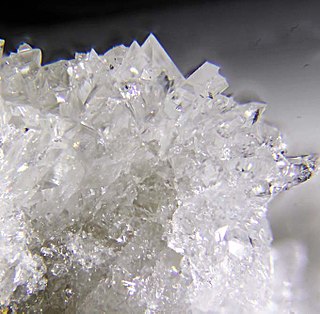 W
WAmicite is a silicate mineral of the zeolite family. It has a general formula of K2Na2Al4Si4O16·5(H2O). Amicite was described in 1979 from specimens obtained at the Höwenegg quarry in Immendingen, Hegau, in the German state of Baden-Württemberg, which is consequently its type locality. The name is in honor of Giovanni Battista Amici (1786–1863) a botanist, physicist, optician, and inventor of microscope optical elements.
 W
WAnalcime or analcite (from the Greek analkimos - "weak") is a white, gray, or colorless tectosilicate mineral. Analcime consists of hydrated sodium aluminium silicate in cubic crystalline form. Its chemical formula is NaAlSi2O6·H2O. Minor amounts of potassium and calcium substitute for sodium. A silver-bearing synthetic variety also exists (Ag-analcite).
 W
WBarrerite is a tectosilicate mineral and a member of the zeolite family. It is one of the rarer zeolites. It was named for Richard Barrer, a New Zealand-born chemist.
 W
WBrewsterite is the name of a series of tectosilicate minerals of the zeolite group. Prior to 1997, brewsterite was recognized as a mineral species, but a reclassification in 1997 by the International Mineralogical Association changed it to a series name, with the mineral species being named brewsterite-Sr and brewsterite-Ba. Brewsterite-Sr, the more common of these, is a hydrous strontium and aluminium silicate, (Sr,Ba)2Al4Si12O32·10H2O. Small amounts of barium is usually present replacing part of the strontium. The appropriate species name depends on the dominant element. The species are visually indistinguishable, and the series name brewsterite is still used whenever testing has not been performed.
 W
WChabazite is a tectosilicate mineral of the zeolite group, closely related to gmelinite, with the chemical formula (Ca,K2,Na2,Mg)Al2Si4O12•6H2O. Recognized varieties include Chabazite-Ca, Chabazite-K, Chabazite-Na, and Chabazite-Sr, depending on the prominence of the indicated cation.
 W
WClinoptilolite is a natural zeolite composed of a microporous arrangement of silica and alumina tetrahedra. It has the complex formula: (Na,K,Ca)2-3Al3(Al,Si)2Si13O36·12H2O. It forms as white, green to reddish tabular monoclinic tectosilicate crystals with a Mohs hardness of 3.5 to 4 and a specific gravity of 2.1 to 2.2. It commonly occurs as a devitrification product of volcanic glass shards in tuff and as vesicle fillings in basalts, andesites and rhyolites. It was described in 1969 from an occurrence in the Barstow Formation, San Bernardino County, California. Sodium levels in clinoptilolite are generally higher than potassium levels, as is the case with the San Bernardino Barstow Formation, but there are sources that are potassium-rich and have minimal sodium.
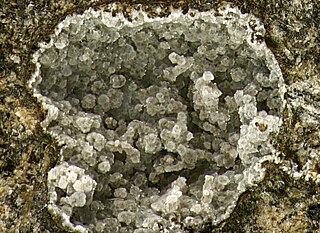 W
WCowlesite is named after American mineralogist John Cowles. It was first described by W.S. Wise and Rudy W. Tschernich in material from roadcuts along Neer Road, Goble, Oregon, United States. The description also incorporated data from Superior, Arizona. It most often occurs as small colorless to white spheres in basalt, and is often associated with other zeolites.
 W
WCu-Y zeolites are derivatives of the faujasite mineral group which in turn is a member of the zeolite family. Cu-Y zeolites are synthesized through aqueous or gaseous ionic exchange unlike the naturally occurring faujasites: faujasite-Ca, faujasite-Mg, and faujasite-Na. The exchanged copper atom can vary in oxidation states, but the most studied Cu-Y zeolite variants include Cu(I) or Cu(II) cations. Due to their high catalytic potential, they are utilized as desulfurization agents and in the production of nitrogen gas from nitrogen monoxide.
 W
WEdingtonite is a white, gray, brown, colorless, pink or yellow zeolite mineral. Its chemical formula is BaAl2Si3O10·4H2O. It has varieties with tetragonal, orthorhombic or triclinic crystals.
 W
WErionite is a naturally occurring fibrous mineral that belongs to a group of minerals called zeolites. It usually is found in volcanic ash that has been altered by weathering and ground water. Erionite forms brittle, wool-like fibrous masses in the hollows of rock formations and has an internal molecular structure similar to chabazite. Some properties of erionite are similar to the properties of asbestos; however, erionite is not currently regulated by the U.S. Environmental Protection Agency and there are no occupational exposure limits for erionite fibers. Erionite was first described by A.S. Eakle in 1898, as white woolly fibrous masses in cavities in rhyolite lava near Durkee, Oregon. It was originally thought to be another relatively rare zeolite named offretite, which is very similar to erionite in appearance and chemical composition.
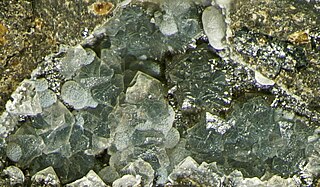 W
WFaujasite is a mineral group in the zeolite family of silicate minerals. The group consists of faujasite-Na, faujasite-Mg and faujasite-Ca. They all share the same basic formula (Na2,Ca,Mg)3.5[Al7Si17O48]·32(H2O) by varying the amounts of sodium, magnesium and calcium. It occurs as a rare mineral in several locations worldwide and is also synthesized industrially.
 W
WThe ferrierite group of zeolite minerals (the FER structure) consists of three very similar species: ferrierite-Mg, ferrierite-Na, and ferrierite-K, based on the dominant cation in the A location. ferrierite-Mg and ferrierite-K are orthorhombic minerals and ferrierite-Na is monoclinic with highly variable cationic composition (Na,K)2Mg(Si,Al)18O36(OH)·9H2O. Calcium and other ions are often also present. They are found in vitreous to pearly, often radiating, spherical aggregates of thin blade-shaped transparent to translucent crystals.
 W
WGarronite-Ca is a fairly rare silicate mineral, from the zeolite, which has been found in a few dozen locations in the world. It was first found in the Glenariff Valley, Garron Plateau, County Antrim, Northern Ireland, and in some locations in Iceland. The name comes from the town of Garron, in Northern Ireland, which is consequently considered its type locality. The name initially used was that of Garronite, without subfixes, but the discovery in 2015 of a garronite with dominant sodium instead of calcium in the position of interchangeable cations made it necessary to use subfixes, remaining as Garronite-Ca, to distinguish it from the new species, Garronite-Na.
 W
WGismondine is a mineral with the chemical formula CaAl2Si2O8·4(H2O). It is a zeolite or hydrated alumino-silicate. It forms colorless, bipyramidal crystals of orthorhombic symmetry.
 W
WGmelinite-Na is one of the rarer zeolites but the most common member of the gmelinite series, gmelinite-Ca, gmelinite-K and gmelinite-Na. It is closely related to the very similar mineral chabazite. Gmelinite was named as a single species in 1825 after Christian Gottlob Gmelin (1792–1860) professor of chemistry and mineralogist from Tübingen, Germany, and in 1997 it was raised to the status of a series.Gmelinite-Na has been synthesised from Na-bearing aluminosilicate gels. The naturally occurring mineral forms striking crystals, shallow, six sided double pyramids, which can be colorless, white, pale yellow, greenish, orange, pink, and red. They have been compared to an angular flying saucer.
 W
WGonnardite is a comparatively rare, fibrous zeolite, natrolite subgroup. Older papers claim that a complete solid solution exists between tetranatrolite and gonnardite, but tetranatrolite was discredited as a separate species in 1999. A series, based on the disorder of the silicon-aluminum in the framework, appears to exist between Na-rich gonnardite and natrolite, Na2(Si3Al2)O10·2H2O.
 W
WHarmotome is a mineral, one of the rarer zeolites; a hydrated barium silicate with formula: (Ba0.5,Ca0.5,Na,K)5Al5,Si11O32·12(H2O). It forms vitreous white well defined monoclinic crystals, often associated with calcite and other zeolites. It has a Mohs hardness of 4 to 5 and a specific gravity of 2.44 to 2.5.
 W
WHeulandite is the name of a series of tecto-silicate minerals of the zeolite group. Prior to 1997, heulandite was recognized as a mineral species, but a reclassification in 1997 by the International Mineralogical Association changed it to a series name, with the mineral species being named:Heulandite-Ca Heulandite-Na Heulandite-K Heulandite-Sr Heulandite-Ba.
 W
WHsianghualite is a tectosilicate of lithium, calcium and beryllium, with fluorine, a member of the zeolite group. It was discovered in 1958 and named for the type locality, Hsiang Hua, 香花, meaning fragrant flower.
 W
WHypothetical zeolites are combinatorial models of potential structures of the minerals known as zeolites. They are four-regular periodic graphs, with vertices representing the tetrahedral atom and the edges representing the bridging oxygen atoms. Alternatively, by ignoring the tetrahedral atoms, zeolites can be represented by a six-valent periodic graph of oxygen atoms, with each O-O edge defining an edge of a tetrahedron.
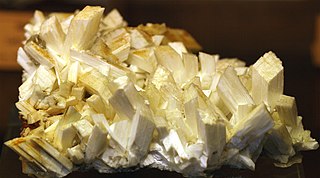 W
WLaumontite is a mineral, one of the zeolite group. Its molecular formula is Ca(AlSi2O6)2·4H2O, a hydrated calcium-aluminium silicate. Potassium or sodium may substitute for the calcium but only in very small amounts.
 W
WLevyne or levynite is a zeolite mineral, i.e. a hydrated silicate mineral. There are two forms of levyne:Levyne-Na, the sodium dominated form (Na2,Ca,K2)Al2Si4O12·6(H2O); and Levyne-Ca the calcium dominated form (Ca,Na2,K2)Al2Si4O12·6(H2O)
 W
WMesolite is a tectosilicate mineral with formula Na2Ca2(Al2Si3O10)3·8H2O. It is a member of the zeolite group and is closely related to natrolite which it also resembles in appearance.
 W
WMordenite is a zeolite mineral with the chemical formula, (Ca, Na2, K2)Al2Si10O24·7H2O. and it is one of the six most abundant zeolites and is used commercially.
 W
WNatrolite is a tectosilicate mineral species belonging to the zeolite group. It is a hydrated sodium and aluminium silicate with the formula Na2Al2Si3O10 • 2H2O. The type locality is Hohentwiel, Hegau, Germany.
 W
WPhillipsite is a mineral series of the zeolite group; a hydrated potassium, calcium and aluminium silicate, approximating to (Ca,Na2,K2)3Al6Si10O32·12H2O. The members of the series are phillipsite-K, phillipsite-Na and phillipsite-Ca. The crystals are monoclinic, but only complex cruciform twins are known, these being exactly like twins of harmotome which also forms a series with phillipsite-Ca. Crystals of phillipsite are, however, usually smaller and more transparent and glassy than those of harmotome. Spherical groups with a radially fibrous structure and bristled with crystals on the surface are not uncommon. The Mohs hardness is 4.5, and the specific gravity is 2.2. The species was established by Armand Lévy in 1825 and named after William Phillips. French authors use the name Christianite (after Christian VIII of Denmark), given by A. Des Cloizeaux in 1847.
 W
WCharles Joseph Plank was a chemist and inventor, who patented the process of zeolite catalytic cracking of hydrocarbons. He is responsible for 83 U.S. patents and several hundred patents outside of the United States.
 W
WPollucite is a zeolite mineral with the formula (Cs,Na)2Al2Si4O12·2H2O with iron, calcium, rubidium and potassium as common substituting elements. It is important as a significant ore of caesium and sometimes rubidium. It forms a solid solution series with analcime. It crystallizes in the isometric - hexoctahedral crystal system as colorless, white, gray, or rarely pink and blue masses. Well formed crystals are rare. It has a Mohs hardness of 6.5 and a specific gravity of 2.9. It has a brittle fracture and no cleavage.
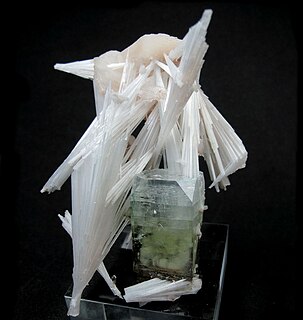 W
WScolecite is a tectosilicate mineral belonging to the zeolite group; it is a hydrated calcium silicate, CaAl2Si3O10·3H2O. Only minor amounts of sodium and traces of potassium substitute for calcium. There is an absence of barium, strontium, iron and magnesium. Scolecite is isostructural (having the same structure) with the sodium-calcium zeolite mesolite and the sodium zeolite natrolite, but it does not form a continuous chemical series with either of them. It was described in 1813, and named from the Greek word, σκώληξ (sko-lecks) = "worm" because of its reaction to the blowpipe flame.
 W
WStellerite is a rare mineral discovered by and named after Georg Wilhelm Steller, a German explorer and zoologist. The mineral has a general formula of Ca[Al2Si7O18]·7H2O. Like most rare minerals, there are few commercial uses for stellerite. Mineral collectors are lucky to find it in good enough crystal form. Zeolites, including stellerite, have been studied using a dehydration process to gauge the potential use of their phases as molecular sieves, sorbents, and catalysts.
 W
WStilbite is the name of a series of tectosilicate minerals of the zeolite group. Prior to 1997, stilbite was recognized as a mineral species, but a reclassification in 1997 by the International Mineralogical Association changed it to a series name, with the mineral species being named:stilbite-Ca stilbite-Na
 W
WThomsonite is the name of a series of tecto-silicate minerals of the zeolite group. Prior to 1997, thomsonite was recognized as a mineral species, but a reclassification in 1997 by the International Mineralogical Association changed it to a series name, with the mineral species being named thomsonite-Ca and thomsonite-Sr. Thomsonite-Ca, by far the more common of the two, is a hydrous sodium, calcium and aluminium silicate, NaCa2Al5Si5O20·6H2O. Strontium can substitute for the calcium and the appropriate species name depends on the dominant element. The species are visually indistinguishable and the series name thomsonite is used whenever testing has not been performed. Globally, thomsonite is one of the rarer zeolites.
 W
WUltramarine is a deep blue color pigment which was originally made by grinding lapis lazuli into a powder. The name comes from the Latin ultramarinus, literally "beyond the sea", because the pigment was imported into Europe from mines in Afghanistan by Italian traders during the 14th and 15th centuries.
 W
WWairakite is a zeolite mineral with an analcime structure but containing a calcium ion. The chemical composition is Ca8(Al16Si32O96)•16H2O. It is named for the location of its discovery in Wairakei, North Island, New Zealand, by Alfred Steiner in 1955. The first finds were in hydrothermally altered rhyolitic tuffs, ignimbrites and volcaniclastic rocks. The mineral has since been found in metamorphic rocks and in geothermal areas. It was most likely first successfully synthesized in a laboratory in 1970.
 W
WZeolites are microporous, aluminosilicate minerals commonly used as commercial adsorbents and catalysts. The term zeolite was originally coined in 1756 by Swedish mineralogist Axel Fredrik Cronstedt, who observed that rapidly heating the material, believed to have been stilbite, produced large amounts of steam from water that had been adsorbed by the material. Based on this, he called the material zeolite, from the Greek ζέω (zéō), meaning "to boil" and λίθος (líthos), meaning "stone". The classic reference for the field has been Breck's book Zeolite Molecular Sieves: Structure, Chemistry, And Use.
 W
WFaujasite is a mineral group in the zeolite family of silicate minerals. The group consists of faujasite-Na, faujasite-Mg and faujasite-Ca. They all share the same basic formula (Na2,Ca,Mg)3.5[Al7Si17O48]·32(H2O) by varying the amounts of sodium, magnesium and calcium. It occurs as a rare mineral in several locations worldwide and is also synthesized industrially.
 W
WFaujasite is a mineral group in the zeolite family of silicate minerals. The group consists of faujasite-Na, faujasite-Mg and faujasite-Ca. They all share the same basic formula (Na2,Ca,Mg)3.5[Al7Si17O48]·32(H2O) by varying the amounts of sodium, magnesium and calcium. It occurs as a rare mineral in several locations worldwide and is also synthesized industrially.
 W
WZSM-5, Zeolite Socony Mobil–5 (framework type MFI from ZSM-5 (five)), is an aluminosilicate zeolite belonging to the pentasil family of zeolites. Its chemical formula is NanAlnSi96–nO192·16H2O (0<n<27). Patented by Mobil Oil Company in 1975, it is widely used in the petroleum industry as a heterogeneous catalyst for hydrocarbon isomerization reactions.